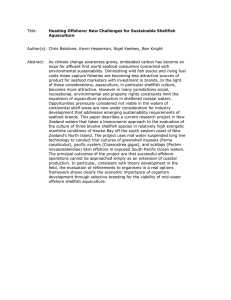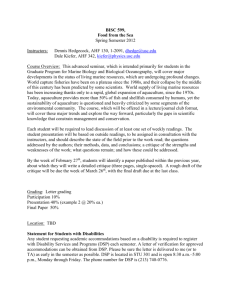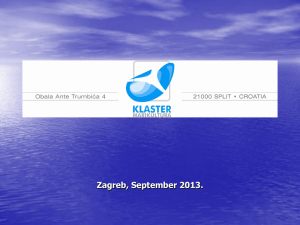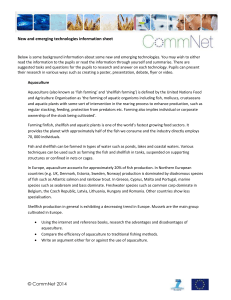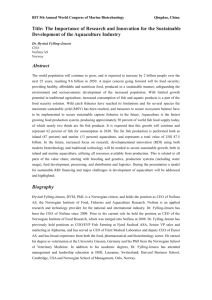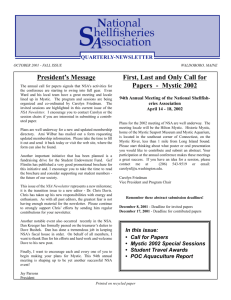Sector : Mineral Extraction (sand & gravel)
advertisement
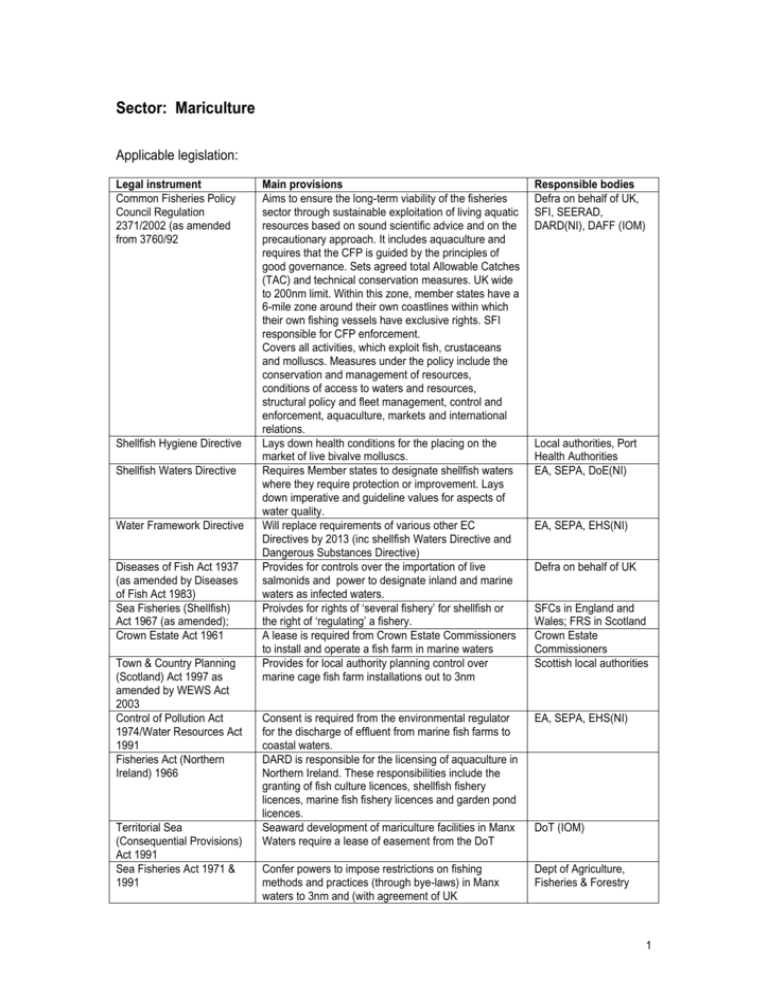
Sector: Mariculture Applicable legislation: Legal instrument Common Fisheries Policy Council Regulation 2371/2002 (as amended from 3760/92 Shellfish Hygiene Directive Shellfish Waters Directive Water Framework Directive Diseases of Fish Act 1937 (as amended by Diseases of Fish Act 1983) Sea Fisheries (Shellfish) Act 1967 (as amended); Crown Estate Act 1961 Town & Country Planning (Scotland) Act 1997 as amended by WEWS Act 2003 Control of Pollution Act 1974/Water Resources Act 1991 Fisheries Act (Northern Ireland) 1966 Territorial Sea (Consequential Provisions) Act 1991 Sea Fisheries Act 1971 & 1991 Main provisions Aims to ensure the long-term viability of the fisheries sector through sustainable exploitation of living aquatic resources based on sound scientific advice and on the precautionary approach. It includes aquaculture and requires that the CFP is guided by the principles of good governance. Sets agreed total Allowable Catches (TAC) and technical conservation measures. UK wide to 200nm limit. Within this zone, member states have a 6-mile zone around their own coastlines within which their own fishing vessels have exclusive rights. SFI responsible for CFP enforcement. Covers all activities, which exploit fish, crustaceans and molluscs. Measures under the policy include the conservation and management of resources, conditions of access to waters and resources, structural policy and fleet management, control and enforcement, aquaculture, markets and international relations. Lays down health conditions for the placing on the market of live bivalve molluscs. Requires Member states to designate shellfish waters where they require protection or improvement. Lays down imperative and guideline values for aspects of water quality. Will replace requirements of various other EC Directives by 2013 (inc shellfish Waters Directive and Dangerous Substances Directive) Provides for controls over the importation of live salmonids and power to designate inland and marine waters as infected waters. Proivdes for rights of ‘several fishery’ for shellfish or the right of ‘regulating’ a fishery. A lease is required from Crown Estate Commissioners to install and operate a fish farm in marine waters Provides for local authority planning control over marine cage fish farm installations out to 3nm Responsible bodies Defra on behalf of UK, SFI, SEERAD, DARD(NI), DAFF (IOM) Consent is required from the environmental regulator for the discharge of effluent from marine fish farms to coastal waters. DARD is responsible for the licensing of aquaculture in Northern Ireland. These responsibilities include the granting of fish culture licences, shellfish fishery licences, marine fish fishery licences and garden pond licences. Seaward development of mariculture facilities in Manx Waters require a lease of easement from the DoT EA, SEPA, EHS(NI) Confer powers to impose restrictions on fishing methods and practices (through bye-laws) in Manx waters to 3nm and (with agreement of UK Dept of Agriculture, Fisheries & Forestry Local authorities, Port Health Authorities EA, SEPA, DoE(NI) EA, SEPA, EHS(NI) Defra on behalf of UK SFCs in England and Wales; FRS in Scotland Crown Estate Commissioners Scottish local authorities DoT (IOM) 1 Legal instrument Marine Pollution Act 1983 Water Pollution Act 1993 Animal Health Act 1996 Main provisions Government) to 12nm. Regulates emissions to Manx coastal waters until it is repealed by the Marine Pollution Act 1983. Regulations on emissions of waste materials. Legislates for the deposits in the Sea (Exemptions) (Isle of Man) Order 1988 which incorporates exemptions for licensing, including seaweed culture or harvest. Provides DAFF with the power to make orders for the purpose of preventing the spread of disease Responsible bodies Definition of mariculture The cultivation of marine organisms under controlled conditions; a synonym for marine aquaculture. The raising of marine finfish or shellfish under some controls. Ponds, pens, tanks, or other containers may be used, and feed is often used. A hatchery is also mariculture but the fish are released before harvest size is reached. Policies, Objectives and Targets Source National Policies No specific policies identified for England and Wales or IOM Scotland In areas recognised for their landscape value planning authorities should ensure that new buildings are located and designed in a sensitive and unobtrusive manner. In commenting on applications for seabed leases planning authorities should acknowledge the potential benefits of marine aquaculture to the local economy while recognising that, on the isolated coast, new or expanded fish farms may be inappropriate. In other areas, particularly where the tourism industry is based on high quality scenery and an unspoilt environment, special attention should be paid to the number of fish farms, their location in relation to each other and the surrounding land mass as well as the design and colour of cages, buoys and other equipment. NPPG13 Coastal Planning Scotland will have a sustainable, diverse, competitive and economically viable aquaculture industry, of which its people can be justifiably proud. It will deliver high quality, healthy food to consumers at home and abroad, and social and economic benefits to communities, particularly in rural and remote areas. It will operate responsibly, working within the carrying capacity of the environment, both locally and nationally and throughout its supply chain. A Strategic Framework for Scottish Aquaculture – para 1.4 and 1.7 to 1.9 Aquaculture should be enabled to make a positive contribution to the Scottish economy through being internationally competitive in the marketplace and economically viable at a national level. The industry should work in harmony with nature, managing and minimising transient environmental impacts, and avoiding significant, cumulative, long-term or irreversible changes to ecological systems, to cultural remains or to valued landscape and scenery. 2 Aquaculture should foster strong community links, recognising and supporting the needs of local communities and working with community initiatives to manage local environments for mutual benefit. It must be integrated within its community, liaising locally and nationally on all appropriate matters. Northern Ireland Source? Seed mussel policy (NI) DARD has provided a formal set of guidelines that set out the management arrangements to apply to seed mussel stocks within the jurisdictions of Ireland and Northern Ireland. National Objectives No objectives identified for England, Wales, NI or IOM There is an assumed objective relating to compliance with Shellfish Waters Directive standards within designated shellfish waters Scotland To achieve an internationally competitive and economically viable industry; To maximise the value to the Scottish economy of the aquaculture industry and its products, both in terms of jobs and investment; To operate within the biological, assimilative and visual carrying capacity of the environment; To ensure that the impact of the industry on the biodiversity, landscape, cultural heritage and recreational uses of the sea and coast is minimised and significant impacts avoided; To ensure that communities are involved in the development of, and benefit both socially and economically from, aquaculture; To encourage more people to benefit from Scotland's healthy, nutritious aquaculture products; To adopt sound welfare conditions in the management of farmed stock; To adopt best practice in the management and control of disease and pathogens and best environmental practice; To provide appropriate regulating support and infrastructure; To encourage the industry to manage its operations in pursuance of these objectives, rather than relying on regulation alone to set operational boundaries; and To demonstrate a responsible approach through continual improvement. National Targets Regional Policies Regional Objectives No specific targets identified No regional policies identified No regional objectives identified Regional Targets No regional targets identified Constraints/Issues CFP: New priorities for support to aquaculture The relations between aquaculture and the environments are extremely important. Adoption of sustainable farming practices must be achieved, alongside the imperatives of health and quality standards for products. The Biodiversity Action Plan for fisheries and aquaculture should contribute to achieving this goal. The Plan should foresee a series of actions related to the Strategic Framework for Scottish Aquaculture – para refs EU Green Paper: The future of the CFP. Volume 1 2002 3 reduction of environmental impact as well as actions to limit the potential problems arising from the introduction of new species and secure animal health. These actions need to be supplemented by research related to aquaculture. Shellfish mariculture constrained in some areas by adverse water quality and poor classification under Shellfish Hygiene Directive The market price for farmed salmon is low and the UK industry has to compete in the European/global market The focus on cost promotes the development of larger fish farms with the potential for greater environmental impact Statement of future needs (and assumptions) 5 years 20 years 4
